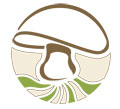Northington: The Grange
Sun 23 Nov 2008
Field event ID HF0827
OS Grid areas: SU5635 SU5636
Weather: Although a cold spell had brought frosts to most of the country temperatures in the South remained just above freezing.
New Records:
New to HFRG: Exidiopsis effusa
Report: (Eric Janke) The weather forecast was better than the apparent outlook when five bold forayers (Stuart Skeates, Alan Lucas, Sue Rogerson, Eric Janke, Simon Moore and Chris Roberts) left the car park in (almost) freezing rain. We had not gone very far before Eric realised he had forgotten his rucksack (aka LUNCH!) when he returned to the cars he collected three late-comers (Tina Facey, Chris Gaffney and Chantra Cozens) and found Chris (Roberts') discarded camera equipment. Soon after the sky started to clear and we were set for an fine day... (negating the need to strip and sing the National Anthem at the end of the foray!).
Our first refuge from the rain revealed considerable numbers of the striking orange cup fungus Melastiza chateri, with brown hairs on the cap edge and mesh-like reticulations on the spores. Later on the largest agarics of the day were pointed out to us by the Baring family, who own the estate, while Sue returned the compliment by showing them the smallest and smelliest - Phleogena faginea (Fenugreek stalkball). Alan found the rare Podostroma alutaceum, which almost compensated the rest of us waiting so long for them to catch us up! A few aged Geastrums were found, but no fresh specimens and the larch plantation had a scattering of fungi, but none of the rarities found in the past. So, on the whole, quite a good foray for the late season, but without too many of the real stars of previous years - role on 2009...
Note: (SJS) Other interesting finds included some fresh specimens of the yellow Crepidotus luteolus and a tiny clustered white cup fungus found by Alan and looking like an ascomycete which subsequently turned out to be the basidiomycete Lachnella villosa. One more new species for the group was Exidiopsis effusa which only has a few previous Hampshire records.
Species list: Agaricus moelleri, Amylostereum laevigatum, Auricularia auricula-judae, Bjerkandera adusta, Byssomerulius corium, Calocera cornea, Calocera viscosa, Chlorophyllum rachodes, Clitocybe geotropa, Clitocybe metachroa, Clitocybe nebularis, Clitocybe rivulosa, Coniophora arida, Coniophora puteana, Coprinellus micaceus, Coprinopsis picacea, Crepidotus cesatii, Crepidotus luteolus, Crepidotus mollis, Cylindrobasidium laeve, Daedaleopsis confragosa, Eichleriella deglubens, Exidia nucleata, Exidiopsis effusa, Flammulina velutipes var. velutipes, Gymnopilus penetrans, Gymnopus peronatus, Hemimycena tortuosa, Heterobasidion annosum, Hygrocybe virginea var. virginea, Hyphodontia arguta, Hyphodontia sambuci, Hypholoma lateritium, Inocybe geophylla var. geophylla, Laccaria laccata, Lachnella villosa, Lachnum niveum, Lepista flaccida, Lepista nuda, Litschauerella clematidis, Lycoperdon pyriforme, Marasmius epiphyllus, Melastiza cornubiensis, Merismodes anomala, Mycena acicula, Mycena arcangeliana, Mycena corynephora, Mycena filopes, Mycena galericulata, Mycena galopus var. galopus, Mycena pura, Mycena speirea, Nectria cinnabarina, Neobulgaria pura var. pura, Peniophora laeta, Peniophora limitata, Peniophora lycii, Peniophora proxima, Phlebiella sulphurea, Phleogena faginea, Physisporinus sanguinolentus, Podostroma alutaceum, Radulomyces confluens, Rhodocollybia butyracea, Schizopora paradoxa, Scutellinia scutellata, Stereum rugosum, Stropharia pseudocyanea, Trametes versicolor, Trechispora cohaerens, Tremella foliacea, Tremella mesenterica, Vuilleminia coryli, Xylaria longipes, Xylaria polymorpha
